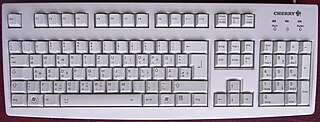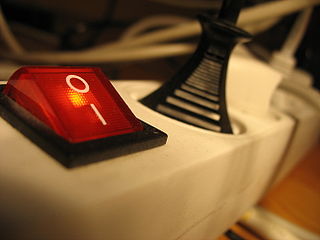
ASCII, an acronym for American Standard Code for Information Interchange, is a character encoding standard for electronic communication. ASCII codes represent text in computers, telecommunications equipment, and other devices. Because of technical limitations of computer systems at the time it was invented, ASCII has just 128 code points, of which only 95 are printable characters, which severely limited its scope. Modern computer systems have evolved to use Unicode, which has millions of code points, but the first 128 of these are the same as the ASCII set.
ISO/IEC 8859 is a joint ISO and IEC series of standards for 8-bit character encodings. The series of standards consists of numbered parts, such as ISO/IEC 8859-1, ISO/IEC 8859-2, etc. There are 15 parts, excluding the abandoned ISO/IEC 8859-12. The ISO working group maintaining this series of standards has been disbanded.

In computing, a Control keyCtrl is a modifier key which, when pressed in conjunction with another key, performs a special operation. Similarly to the Shift key, the Control key rarely performs any function when pressed by itself. The Control key is located on or near the bottom left side of most keyboards, with many featuring an additional one at the bottom right.

The Shift key⇧ Shift is a modifier key on a keyboard, used to type capital letters and other alternate "upper" characters. There are typically two shift keys, on the left and right sides of the row below the home row. The Shift key's name originated from the typewriter, where one had to press and hold the button to shift up the case stamp to change to capital letters; the shift key was first used in the Remington No. 2 Type-Writer of 1878; the No. 1 model was capital-only. On the US layout and similar keyboard layouts, characters that typically require the use of the shift key include the parentheses, the question mark, the exclamation point, and the colon.

Michael Everson is an American and Irish linguist, script encoder, typesetter, type designer and publisher. He runs a publishing company called Evertype, through which he has published over one hundred books since 2006.
T.61 is an ITU-T Recommendation for a Teletex character set. T.61 predated Unicode, and was the primary character set in ASN.1 used in early versions of X.500 and X.509 for encoding strings containing characters used in Western European languages. It is also used by older versions of LDAP. While T.61 continues to be supported in modern versions of X.500 and X.509, it has been deprecated in favor of Unicode. It is also called Code page 1036, CP1036, or IBM 01036.

On computer keyboards, the enter key⌅ Enter and return key↵ Return are two closely related keys with overlapping and distinct functions dependent on operating system and application.

On computer keyboards, the Esc keyEsc is a key used to generate the escape character. The escape character, when sent from the keyboard to a computer, often is interpreted by software as "stop", "cancel" or "exit", and when sent from the computer to an external device marks the beginning of an escape sequence to specify operating modes or characteristics generally.
In Unicode, a Private Use Area (PUA) is a range of code points that, by definition, will not be assigned characters by the Unicode Consortium. Three private use areas are defined: one in the Basic Multilingual Plane, and one each in, and nearly covering, planes 15 and 16. The code points in these areas cannot be considered as standardized characters in Unicode itself. They are intentionally left undefined so that third parties may define their own characters without conflicting with Unicode Consortium assignments. Under the Unicode Stability Policy, the Private Use Areas will remain allocated for that purpose in all future Unicode versions.
The C0 and C1 control code or control character sets define control codes for use in text by computer systems that use ASCII and derivatives of ASCII. The codes represent additional information about the text, such as the position of a cursor, an instruction to start a new line, or a message that the text has been received.

〒 is the service mark of Japan Post and its successor, Japan Post Holdings, the postal operator in Japan. It is also used as a Japanese postal code mark since the introduction of the latter in 1968. Historically, it was used by the Ministry of Communications, which operated the postal service. The mark is a stylized katakana syllable te (テ), from the word teishin. The mark was introduced on February 8, 1887.

A power symbol is a symbol indicating that a control activates or deactivates a particular device. Such a control may be a rocker switch, a toggle switch, a push-button, a virtual switch on a display screen, or some other user interface. The internationally standardized symbols are intended to communicate their function in a language-independent manner.
Miscellaneous Technical is a Unicode block ranging from U+2300 to U+23FF, which contains various common symbols which are related to and used in the various technical, programming language, and academic professions. For example:
In computing, a Unicode symbol is a Unicode character which is not part of a script used to write a natural language, but is nonetheless available for use as part of a text.
ISO/IEC 9995Information technology — Keyboard layouts for text and office systems is an ISO/IEC standard series defining layout principles for computer keyboards. It does not define specific layouts but provides the base for national and industry standards which define such layouts.
KPS 9566 is a North Korean standard specifying a character encoding for the Chosŏn'gŭl (Hangul) writing system used for the Korean language. The edition of 1997 specified an ISO 2022-compliant 94×94 two-byte coded character set. Subsequent editions have added additional encoded characters outside of the 94×94 plane, in a manner comparable to UHC or GBK.
The Universal Coded Character Set is a standard set of characters defined by the international standard ISO/IEC 10646, Information technology — Universal Coded Character Set (UCS), which is the basis of many character encodings, improving as characters from previously unrepresented typing systems are added.
In mathematics, the radical symbol, radical sign, root symbol, radix, or surd is a symbol for the square root or higher-order root of a number. The square root of a number x is written as
ISO/IEC JTC 1/SC 2 Coded character sets is a standardization subcommittee of the Joint Technical Committee ISO/IEC JTC 1 of the International Organization for Standardization (ISO) and the International Electrotechnical Commission (IEC), that develops and facilitates standards within the field of coded character sets. The international secretariat of ISO/IEC JTC 1/SC 2 is the Japanese Industrial Standards Committee (JISC), located in Japan. SC 2 is responsible for the development of the Universal Coded Character Set standard, which is the international standard corresponding to the Unicode Standard.
KS X 1002 is a South Korean character set standard established in order to supplement KS X 1001. It consists of a total of 7,649 characters.



![A washing machine with an illuminated Play/Pause ([?]) symbol. Washing machine Media Symbols.jpg](http://upload.wikimedia.org/wikipedia/commons/thumb/b/b9/Washing_machine_Media_Symbols.jpg/220px-Washing_machine_Media_Symbols.jpg)







